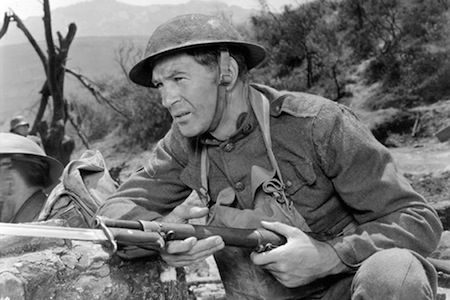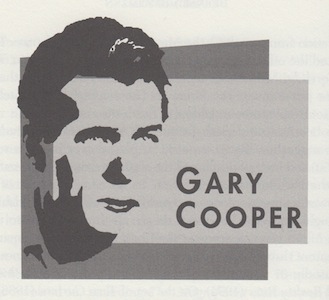Born: May 7, 1901, Helena, MT
Died: May 13, 1961, Los Angeles, CA
Cooper took a cut in salary and got, in compensation, what is now called a ‘participation.’
—Kenneth MacGowan
As a weekend guide at Yellowstone National Park, Gary Cooper spent his idle time dreaming of a job on a big newspaper, drawing cartoons for a living. But a trip to California in 1924 landed him work as a movie extra, where he utilized his horseback skills in a number of westerns as a cowboy heavy and stunt rider. A two-year string of two-reelers brought him to the attention of Sam Goldwyn, and he was cast in The Winning of Barbara Worth (1926), a big box office hit. By the time talking pictures like The Virginian (1929) rolled into town, Cooper was building a following among audiences. His plain features and unaffected manner made him a natural hero in other adventures—Morocco (1930), The Plainsman (1937) and Beau Geste (1939)—and his role as the soldier in Hemingway’s A Farewell to Arms (1932) cemented him as a romantic lead.
To millions of men and women, Cooper embodied honor and decency. This type was particularly effective when directors put him into sophisticated settings and let his awkward charm win over hearts, as Frank Capra did in Meet John Doe (1941). Years before Jimmy Stewart became Capra’s golden boy, Gary Cooper was filling the role nicely. Capra is often credited with the creation of Cooper’s man-of-few-words character, but the “Yup” fellow of several early Cooper pictures was more the creation of pulp writer Clarence Budington Kelland, a prolific writer of extremely popular dime novels and serialized magazine stories. Kelland’s tales reflected a small-town philosophy and patriotic bent that inspired these films. One of Kelland’s bestsellers became Mr. Deeds Goes to Town (1936), and Cooper’s portrayal of a simple, plain-speaking man owes more to Kelland’s writing than it does to Capra’s direction. The laconic acting style of these films became a Cooper legacy that has had a tremendous influence on hundreds of actors. The tight-lipped, understated performances of Clint Eastwood hail directly from Cooper, whose unpolished and hesitant do-gooders only moved when they felt compelled to take action.
In 1941, Cooper starred in Sergeant York; along with an Oscar for the role came huge paychecks. The U.S. Treasury Department released a report that year showing Cooper as the nation’s highest-paid wage-earner. Earning $482,819 he sent a signal to America that movie stars were the nouveau-riche. He made a much-publicized trip to Europe, where he was greeted like a king and became romantically involved with a real-life princess. To his fans worldwide, his skyrocketing fame crystallized the idea of the rags-to-riches dream.
Another significant development would make Cooper even wealthier. His contracts were rewritten to allow him a percentage of the ticket grosses in exchange for a lower wage. Soon, the homespun park ranger would be a multimillionaire, and dozens of the top stars in Hollywood would take notice and gamble their futures on the financial success of their films. Jimmy Stewart, James Cagney, Bette Davis, Katharine Hepburn and Humphrey Bogart were just some of the stars who changed their compensation packages to include the “percentage” clauses.
Cooper stayed on top at the box office by partnering with many of the day’s leading ladies—including the immeasurably talented Shirley Temple. His aptitude for strong, silent acting continued to be displayed in such roles as ballplayer Lou Gehrig in The Pride of the Yankees (1942), Robert Jordan in the adaptation of Ernest Hemingway’s For Whom the Bell Tolls (1943), and Howard Roark in The Fountainhead (1949), based on Ayn Rand’s bestselling novel. His weathered looks cost him some roles until a script for a western provided Cooper with the perfect part for a return to the saddle. High Noon (1952) clinched him another Oscar for his definitive performance of an aging gunslinger, a role that would foreshadow the memorable turns of William Holden in The Wild Bunch (1973), John Wayne in The Shootist (1976) and Clint Eastwood in his haunting Unforgiven (1992).
Cooper received a special Academy Award in 1961, accepted on his behalf by a tearful James Stewart, who had moments earlier learned of Cooper’s bout with incurable cancer. One month later, Gary Cooper died at age sixty. He is remembered as a straightforward actor who embodied a plain truth, and the influence of his restrained style on today’s actors is notable enough to earn him a ranking on this list. His high placement here also takes into account the way in which he changed the business of acting. While many contemporary actors enjoy large portions of a film’s sales receipts, it’s important to acknowledge Cooper as the first person to get royalties for actors and to turn actors into royalty.
To read all the republished articles from ‘The Film 100,’ go to Reintroducing the Film 100 here on Keyframe.





